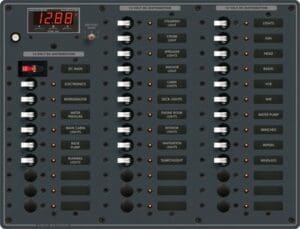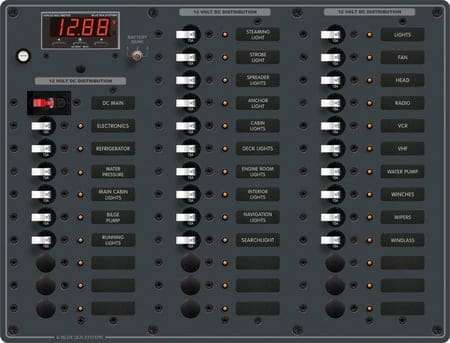by Bill Morris

As a vessel and its crew evolve together, new electrical systems replace the old, and often new switches are added on separate mounts in odd places throughout the cabin and pilothouse, creating a confusing and potentially hazardous living space.
Installing one or more new electrical panels, including a few extra switches for future equipment add-ons, will alleviate the headache and cluttered appearance of a cabin full of multicolored lights glowing like a Christmas tree. With the multitude of manufacturers and panel styles, both AC and DC, available on the market, you should have no trouble picking out a unit well suited to your boat.
Paneltronics of Hialeah Gardens, Florida, produces a wide range of panels, from their humble, waterproof, six-position DC toggle and rocker switch panels to a 12-position panel with LED charge meter. Paneltronics also produces a lot of custom designs fitted to the specific space allowance and onboard electrical grid requirements of a given vessel.
With prices ranging from less than $100 for a panel with six rubber-booted toggle switches and amber LED indicator lights to a large, custom panel with more than two dozen switches and two or more charge meters, Paneltronics can accommodate virtually any onboard electrical system with one panel or multiple-panel array.
Blue Sea Systems, a name familiar to many coastal and offshore sailors, has a wide selection of 12V/24V panels covering a range of sizes, from a small-boat, six-position device selling for around $200 to their large, 36-position Blue Sea 8382 DC Panel. As of this writing, the 8382, normally priced at $1,721, is on sale for $1,329, a savings of nearly 400 bucks.
Xantrex as well produces a broad assortment of electrical panels and controls, starting with their Freedom X/XC remote charge indicator panel, which uses a blue graphic display to indicate battery charge, load as measured in watts and three battery indicator lights. The unit is available for roughly $80 and offers peace of mind when we need a quick read on battery charge.
At the upper end of their product line, Xantrex also designs and produces large, custom AC/DC panels for luxury yacht builders. Large arrays come with one or more Xantrex Gateway touchscreen panels, which are customized to meet the demands of large luxury yachts.
Yet another name familiar to sailors is Sea Dog, which specializes in panels for small boats. Their six-gang breaker-rocker switch panels come in several styles, from an LED-illuminated panel with power socket to an unlit version with a silicone rubber splash cover.
Each of Sea Dog’s toggle and rocker panels comes with a push-button fuse holder on the front of the panel, allowing for easy access. At less than $40 for a product well known to many coastal and offshore sailors, it’s hard to imagine a better buy for a small boat.
For those of you seeking a genuinely custom switch array on your floating palace, take a look at the selection of electrical panels from AC/DC Marine in Carson, Calif. The company produces a long list of customizable gauges, engine panels and charging systems, giving you a choice of either traditional analog dials and switches or touch-screen digital displays.
While a set of AC/DC Marine gauges starts at $450, a NMEA 2000 touch-screen, multicolor display, including vessel speedometer, tachometer, depth sounder and compass with heading costs a little more than $1,000, a lot of value for a modest investment.
The list of affordable, high-quality instrument panels for sailing craft continues to evolve into better-quality devices at prices affordable for even the humblest sailing kitty. Identify your vessel’s instrument needs, and enjoy safer sailing voyages with high-quality equipment and affordable prices.
Circumnavigator-author Bill Morris believes the best strategy for succeeding as an offshore voyager is to keep systems simple and, if possible, manual. Key to survival are a windvane self-steering system, a basic array of electronics and an aggressive alternative energy battery charging matrix. Bill is a contributing editor to Ocean Navigator and the author of The Windvane Self-Steering Handbook (International Marine, 2004) and The Captain’s Guide to Alternative Energy Afloat (Seaworthy Publications, 2019).

